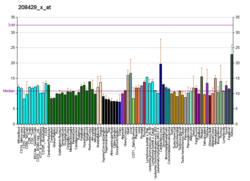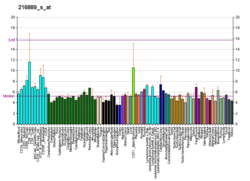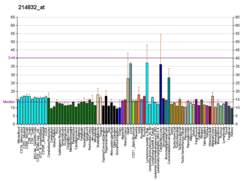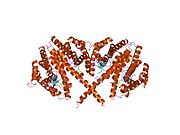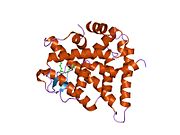Protein-coding gene in the species Homo sapiens
Hepatocyte nuclear factor 4 alpha (HNF4A) also known as NR2A1 (nuclear receptor subfamily 2, group A, member 1) is a nuclear receptor that in humans is encoded by the HNF4A gene.
Function
HNF-4α is a nuclear transcription factor that binds DNA as a homodimer. The encoded protein controls the expression of several genes, including hepatocyte nuclear factor 1 alpha, a transcription factor that regulates the expression of several hepatic genes. This gene plays a role in development of the liver, kidney, and intestines. Alternative splicing of this gene results in multiple transcript variants.
HNF4A is required for the PXR and CAR-mediated transcriptional activation of CYP3A4. Genetic mutations in the HNF4A gene can influence the activity of HNF4α's downstream proteins such as CYP2D6, in vitro and in vivo.
The alkaloid berberine upregulates HNF4A expression.
This gene plays a pivotal role in the expression and synthesis of SHBG, an important glycoprotein made primarily in the liver, which in addition to lowering insulin-resistance also reduces levels of free Estrogen as-well as prolonging the half-life of testosterone.
Function of HNF4A gene can be effectively examined by siRNA knockdown based on an independent validation.
Clinical significance
Mutations in the HNF4A gene are associated with a form of diabetes called maturity onset diabetes of the young (MODY), specifically MODY 1. At least 56 disease-causing mutations in this gene have been discovered.
Increased amplification of hepatocyte nuclear factor 4 alpha has been observed in colorectal cancer.
It has also associations with the appearance of Fanconi syndrome phenotypes which occurs due to a missense mutation of the gene.
Interactions
Hepatocyte nuclear factor 4 alpha has been shown to interact with:
See also
References
- ^ GRCh38: Ensembl release 89: ENSG00000101076 – Ensembl, May 2017
- ^ GRCm38: Ensembl release 89: ENSMUSG00000017950 – Ensembl, May 2017
- "Human PubMed Reference:". National Center for Biotechnology Information, U.S. National Library of Medicine.
- "Mouse PubMed Reference:". National Center for Biotechnology Information, U.S. National Library of Medicine.
- Chartier FL, Bossu JP, Laudet V, Fruchart JC, Laine B (Sep 1994). "Cloning and sequencing of cDNAs encoding the human hepatocyte nuclear factor 4 indicate the presence of two isoforms in human liver". Gene. 147 (2): 269–72. doi:10.1016/0378-1119(94)90079-5. PMID 7926813.
- Argyrokastritis A, Kamakari S, Kapsetaki M, Kritis A, Talianidis I, Moschonas NK (Feb 1997). "Human hepatocyte nuclear factor-4 (hHNF-4) gene maps to 20q12-q13.1 between PLCG1 and D20S17". Human Genetics. 99 (2): 233–6. doi:10.1007/s004390050345. PMID 9048927. S2CID 10943721.
- "Entrez Gene: HNF4A hepatocyte nuclear factor 4, alpha".
- Tirona RG, Lee W, Leake BF, Lan LB, Cline CB, Lamba V, Parviz F, Duncan SA, Inoue Y, Gonzalez FJ, Schuetz EG, Kim RB (Feb 2003). "The orphan nuclear receptor HNF4alpha determines PXR- and CAR-mediated xenobiotic induction of CYP3A4". Nature Medicine. 9 (2): 220–4. doi:10.1038/nm815. PMID 12514743. S2CID 8925996.
- Lee SS, Cha EY, Jung HJ, Shon JH, Kim EY, Yeo CW, Shin JG (2008). "Genetic polymorphism of hepatocyte nuclear factor-4alpha influences human cytochrome P450 2D6 activity". Hepatology. 48 (2): 635–45. doi:10.1002/hep.22396. PMID 18666237. S2CID 205866107.
- Jiang F, Yeo CW, Lee SS, Oh MK, Ghim JL, Shon JH, Kim HS, Kim EY, Kim DH, Shin JG (2013). "Effect of HNF4α genetic polymorphism G60D on the pharmacokinetics of CYP2D6 substrate tolterodine in healthy Korean individuals". Pharmacogenetics and Genomics. 23 (3): 175–9. doi:10.1097/FPC.0b013e32835de25e. PMID 23292115. S2CID 19230792.
- Wang ZQ, Lu FE, Leng SH, Fang XS, Chen G, Wang ZS, Dong LP, Yan ZQ (Oct 2008). "Facilitating effects of berberine on rat pancreatic islets through modulating hepatic nuclear factor 4 alpha expression and glucokinase activity". World Journal of Gastroenterology. 14 (39): 6004–11. doi:10.3748/wjg.14.6004. PMC 2760199. PMID 18932278.
- Hammond GL, Bocchinfuso WP (2008-12-09). "Sex hormone-binding globulin: gene organization and structure/function analyses". Hormone Research. 45 (3–5): 197–201. doi:10.1159/000184787 (inactive 23 December 2024). PMID 8964583.
{{cite journal}}: CS1 maint: DOI inactive as of December 2024 (link) - Munkácsy G, Sztupinszki Z, Herman P, Bán B, Pénzváltó Z, Szarvas N, Győrffy B (September 2016). "Validation of RNAi Silencing Efficiency Using Gene Array Data shows 18.5% Failure Rate across 429 Independent Experiments". Molecular Therapy. Nucleic Acids. 5 (9): e366. doi:10.1038/mtna.2016.66. PMC 5056990. PMID 27673562.
- Yamagata K (2014). "Roles of HNF1α and HNF4α in pancreatic β-cells: lessons from a monogenic form of diabetes (MODY)". Vitamins and Hormones. 95: 407–23. doi:10.1016/B978-0-12-800174-5.00016-8. PMID 24559927.
- Šimčíková D, Heneberg P (December 2019). "Refinement of evolutionary medicine predictions based on clinical evidence for the manifestations of Mendelian diseases". Scientific Reports. 9 (1): 18577. Bibcode:2019NatSR...918577S. doi:10.1038/s41598-019-54976-4. PMC 6901466. PMID 31819097.
- Zhang B, Wang J, Wang X, Zhu J, Liu Q, Shi Z, Chambers MC, Zimmerman LJ, Shaddox KF, Kim S, Davies SR, Wang S, Wang P, Kinsinger CR, Rivers RC, Rodriguez H, Townsend RR, Ellis MJ, Carr SA, Tabb DL, Coffey RJ, Slebos RJ, Liebler DC (2014). "Proteogenomic characterization of human colon and rectal cancer". Nature. 513 (7518): 382–7. Bibcode:2014Natur.513..382.. doi:10.1038/nature13438. PMC 4249766. PMID 25043054.
- Kashoor I, Batlle D (September 2019). "Proximal renal tubular acidosis with and without Fanconi syndrome". Kidney Research and Clinical Practice. 38 (3): 267–281. doi:10.23876/j.krcp.19.056. PMC 6727890. PMID 31474092.
- Mulholland DJ, Read JT, Rennie PS, Cox ME, Nelson CC (Aug 2003). "Functional localization and competition between the androgen receptor and T-cell factor for nuclear beta-catenin: a means for inhibition of the Tcf signaling axis". Oncogene. 22 (36): 5602–13. doi:10.1038/sj.onc.1206802. PMID 12944908. S2CID 9301471.
- Yoshida E, Aratani S, Itou H, Miyagishi M, Takiguchi M, Osumu T, Murakami K, Fukamizu A (Dec 1997). "Functional association between CBP and HNF4 in trans-activation". Biochemical and Biophysical Research Communications. 241 (3): 664–9. doi:10.1006/bbrc.1997.7871. PMID 9434765.
- Dell H, Hadzopoulou-Cladaras M (Mar 1999). "CREB-binding protein is a transcriptional coactivator for hepatocyte nuclear factor-4 and enhances apolipoprotein gene expression". The Journal of Biological Chemistry. 274 (13): 9013–21. doi:10.1074/jbc.274.13.9013. PMID 10085149.
- ^ Maeda Y, Rachez C, Hawel L, Byus CV, Freedman LP, Sladek FM (Jul 2002). "Polyamines modulate the interaction between nuclear receptors and vitamin D receptor-interacting protein 205". Molecular Endocrinology. 16 (7): 1502–10. doi:10.1210/mend.16.7.0883. PMID 12089346.
- ^ Malik S, Wallberg AE, Kang YK, Roeder RG (Aug 2002). "TRAP/SMCC/mediator-dependent transcriptional activation from DNA and chromatin templates by orphan nuclear receptor hepatocyte nuclear factor 4". Molecular and Cellular Biology. 22 (15): 5626–37. doi:10.1128/MCB.22.15.5626-5637.2002. PMC 133960. PMID 12101254.
- Lee YK, Dell H, Dowhan DH, Hadzopoulou-Cladaras M, Moore DD (Jan 2000). "The orphan nuclear receptor SHP inhibits hepatocyte nuclear factor 4 and retinoid X receptor transactivation: two mechanisms for repression". Molecular and Cellular Biology. 20 (1): 187–95. doi:10.1128/MCB.20.1.187-195.2000. PMC 85074. PMID 10594021.
- Lin WJ, Li J, Lee YF, Yeh SD, Altuwaijri S, Ou JH, Chang C (Mar 2003). "Suppression of hepatitis B virus core promoter by the nuclear orphan receptor TR4". The Journal of Biological Chemistry. 278 (11): 9353–60. doi:10.1074/jbc.M205944200. PMID 12522137.
Further reading
- Winter WE, Nakamura M, House DV (Dec 1999). "Monogenic diabetes mellitus in youth. The MODY syndromes". Endocrinology and Metabolism Clinics of North America. 28 (4): 765–85. doi:10.1016/S0889-8529(05)70101-8. PMID 10609119.
- Zannis VI, Kan HY, Kritis A, Zanni E, Kardassis D (Mar 2001). "Transcriptional regulation of the human apolipoprotein genes". Frontiers in Bioscience. 6: D456-504. doi:10.2741/Zannis. PMID 11229886.
- Gupta RK, Kaestner KH (Nov 2004). "HNF-4alpha: from MODY to late-onset type 2 diabetes". Trends in Molecular Medicine. 10 (11): 521–4. doi:10.1016/j.molmed.2004.09.004. PMID 15519277.
- Mohlke KL, Boehnke M (Apr 2005). "The role of HNF4A variants in the risk of type 2 diabetes". Current Diabetes Reports. 5 (2): 149–56. doi:10.1007/s11892-005-0043-y. PMID 15794920. S2CID 1661923.
- Love-Gregory L, Permutt MA (Jul 2007). "HNF4A genetic variants: role in diabetes". Current Opinion in Clinical Nutrition and Metabolic Care. 10 (4): 397–402. doi:10.1097/MCO.0b013e3281e3888d. PMID 17563455. S2CID 10318597.
- Bell GI, Xiang KS, Newman MV, Wu SH, Wright LG, Fajans SS, Spielman RS, Cox NJ (Feb 1991). "Gene for non-insulin-dependent diabetes mellitus (maturity-onset diabetes of the young subtype) is linked to DNA polymorphism on human chromosome 20q". Proceedings of the National Academy of Sciences of the United States of America. 88 (4): 1484–8. Bibcode:1991PNAS...88.1484B. doi:10.1073/pnas.88.4.1484. PMC 51043. PMID 1899928.
- Ktistaki E, Ktistakis NT, Papadogeorgaki E, Talianidis I (Oct 1995). "Recruitment of hepatocyte nuclear factor 4 into specific intranuclear compartments depends on tyrosine phosphorylation that affects its DNA-binding and transactivation potential". Proceedings of the National Academy of Sciences of the United States of America. 92 (21): 9876–80. Bibcode:1995PNAS...92.9876K. doi:10.1073/pnas.92.21.9876. PMC 40905. PMID 7568236.
- Ginsburg GS, Ozer J, Karathanasis SK (Jul 1995). "Intestinal apolipoprotein AI gene transcription is regulated by multiple distinct DNA elements and is synergistically activated by the orphan nuclear receptor, hepatocyte nuclear factor 4". The Journal of Clinical Investigation. 96 (1): 528–38. doi:10.1172/JCI118065. PMC 185227. PMID 7615825.
- Jiang G, Nepomuceno L, Hopkins K, Sladek FM (Sep 1995). "Exclusive homodimerization of the orphan receptor hepatocyte nuclear factor 4 defines a new subclass of nuclear receptors". Molecular and Cellular Biology. 15 (9): 5131–43. doi:10.1128/mcb.15.9.5131. PMC 230760. PMID 7651430.
- Chartier FL, Bossu JP, Laudet V, Fruchart JC, Laine B (Sep 1994). "Cloning and sequencing of cDNAs encoding the human hepatocyte nuclear factor 4 indicate the presence of two isoforms in human liver". Gene. 147 (2): 269–72. doi:10.1016/0378-1119(94)90079-5. PMID 7926813.
- Drewes T, Senkel S, Holewa B, Ryffel GU (Mar 1996). "Human hepatocyte nuclear factor 4 isoforms are encoded by distinct and differentially expressed genes". Molecular and Cellular Biology. 16 (3): 925–31. doi:10.1128/mcb.16.3.925. PMC 231074. PMID 8622695.
- Yamagata K, Furuta H, Oda N, Kaisaki PJ, Menzel S, Cox NJ, Fajans SS, Signorini S, Stoffel M, Bell GI (Dec 1996). "Mutations in the hepatocyte nuclear factor-4alpha gene in maturity-onset diabetes of the young (MODY1)". Nature. 384 (6608): 458–60. Bibcode:1996Natur.384..458Y. doi:10.1038/384458a0. hdl:2027.42/62605. PMID 8945471. S2CID 4253951.
- Kritis AA, Argyrokastritis A, Moschonas NK, Power S, Katrakili N, Zannis VI, Cereghini S, Talianidis I (Sep 1996). "Isolation and characterization of a third isoform of human hepatocyte nuclear factor 4". Gene. 173 (2): 275–80. doi:10.1016/0378-1119(96)00183-7. PMID 8964514.
- Argyrokastritis A, Kamakari S, Kapsetaki M, Kritis A, Talianidis I, Moschonas NK (Feb 1997). "Human hepatocyte nuclear factor-4 (hHNF-4) gene maps to 20q12-q13.1 between PLCG1 and D20S17". Human Genetics. 99 (2): 233–6. doi:10.1007/s004390050345. PMID 9048927. S2CID 10943721.
- Thénot S, Henriquet C, Rochefort H, Cavaillès V (May 1997). "Differential interaction of nuclear receptors with the putative human transcriptional coactivator hTIF1". The Journal of Biological Chemistry. 272 (18): 12062–8. doi:10.1074/jbc.272.18.12062. PMID 9115274.
- Bulman MP, Dronsfield MJ, Frayling T, Appleton M, Bain SC, Ellard S, Hattersley AT (Jul 1997). "A missense mutation in the hepatocyte nuclear factor 4 alpha gene in a UK pedigree with maturity-onset diabetes of the young". Diabetologia. 40 (7): 859–62. doi:10.1007/s001250050760. PMID 9243109.
- Møller AM, Urhammer SA, Dalgaard LT, Reneland R, Berglund L, Hansen T, Clausen JO, Lithell H, Pedersen O (Aug 1997). "Studies of the genetic variability of the coding region of the hepatocyte nuclear factor-4alpha in Caucasians with maturity onset NIDDM". Diabetologia. 40 (8): 980–3. doi:10.1007/s001250050778. PMID 9267996.
- Lindner T, Gragnoli C, Furuta H, Cockburn BN, Petzold C, Rietzsch H, Weiss U, Schulze J, Bell GI (Sep 1997). "Hepatic function in a family with a nonsense mutation (R154X) in the hepatocyte nuclear factor-4alpha/MODY1 gene". The Journal of Clinical Investigation. 100 (6): 1400–5. doi:10.1172/JCI119660. PMC 508318. PMID 9294105.
- Furuta H, Iwasaki N, Oda N, Hinokio Y, Horikawa Y, Yamagata K, Yano N, Sugahiro J, Ogata M, Ohgawara H, Omori Y, Iwamoto Y, Bell GI (Oct 1997). "Organization and partial sequence of the hepatocyte nuclear factor-4 alpha/MODY1 gene and identification of a missense mutation, R127W, in a Japanese family with MODY". Diabetes. 46 (10): 1652–7. doi:10.2337/diabetes.46.10.1652. PMID 9313765.
- Stoffel M, Duncan SA (Nov 1997). "The maturity-onset diabetes of the young (MODY1) transcription factor HNF4alpha regulates expression of genes required for glucose transport and metabolism". Proceedings of the National Academy of Sciences of the United States of America. 94 (24): 13209–14. Bibcode:1997PNAS...9413209S. doi:10.1073/pnas.94.24.13209. PMC 24288. PMID 9371825.
External links
This article incorporates text from the United States National Library of Medicine, which is in the public domain.
| PDB gallery | |
|---|---|
| Transcription factors and intracellular receptors | |||||||||||||||||||||||||||||||
|---|---|---|---|---|---|---|---|---|---|---|---|---|---|---|---|---|---|---|---|---|---|---|---|---|---|---|---|---|---|---|---|
| |||||||||||||||||||||||||||||||
| |||||||||||||||||||||||||||||||
| |||||||||||||||||||||||||||||||
| |||||||||||||||||||||||||||||||
| |||||||||||||||||||||||||||||||
| see also transcription factor/coregulator deficiencies | |||||||||||||||||||||||||||||||





